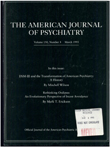Declining frequency of neuroleptic malignant syndrome in a hospital population
Abstract
OBJECTIVE: The authors investigated trends in the frequency of neuroleptic malignant syndrome at their center over a period of 8 years and assessed possible reasons for these trends. METHOD: They used previously defined operational criteria in conducting a prospective survey of cases of the syndrome among 2,695 neuroleptic-treated patients from Oct. 1, 1986, to Aug. 31, 1990. The frequency of neuroleptic malignant syndrome during this period was then compared with the frequency in a comparable period prior to October 1986. The investigators also assessed changes between the two periods in risk factors associated with the syndrome, including patients' mean age, sex ratio, diagnoses, and severity of illness; neuroleptic dosage, potency, and route of administration; concomitant use of lithium; and degree of agitation. RESULTS: Four cases of neuroleptic malignant syndrome were diagnosed during the more recent 47-month survey period, yielding a frequency of 0.15% +/- 0.05%. This represents a significant decline in the frequency of the syndrome from the estimate of 1.10% +/- 0.40% for the earlier survey period. Significantly fewer patients in the recent period had received intramuscular doses of neuroleptics. CONCLUSIONS: The frequency of neuroleptic malignant syndrome has declined significantly at this center. The decline appears to be attributable to increasing clinical awareness of the features of the syndrome, allowing early intervention and treatment, and to a reduction in risk factors, such as use of intramuscular neuroleptics.
Access content
To read the fulltext, please use one of the options below to sign in or purchase access.- Personal login
- Institutional Login
- Sign in via OpenAthens
- Register for access
-
Please login/register if you wish to pair your device and check access availability.
Not a subscriber?
PsychiatryOnline subscription options offer access to the DSM-5 library, books, journals, CME, and patient resources. This all-in-one virtual library provides psychiatrists and mental health professionals with key resources for diagnosis, treatment, research, and professional development.
Need more help? PsychiatryOnline Customer Service may be reached by emailing [email protected] or by calling 800-368-5777 (in the U.S.) or 703-907-7322 (outside the U.S.).



